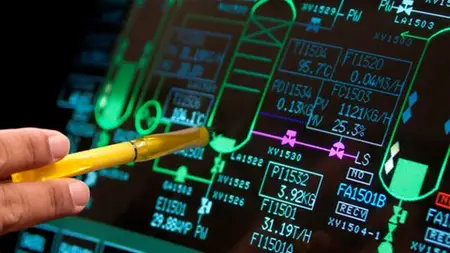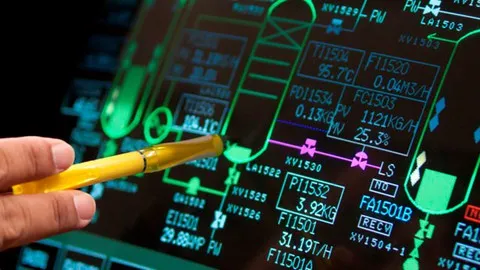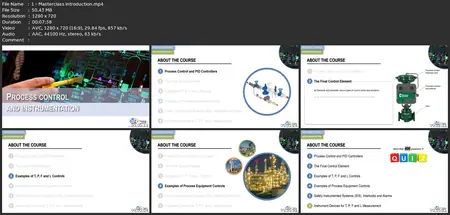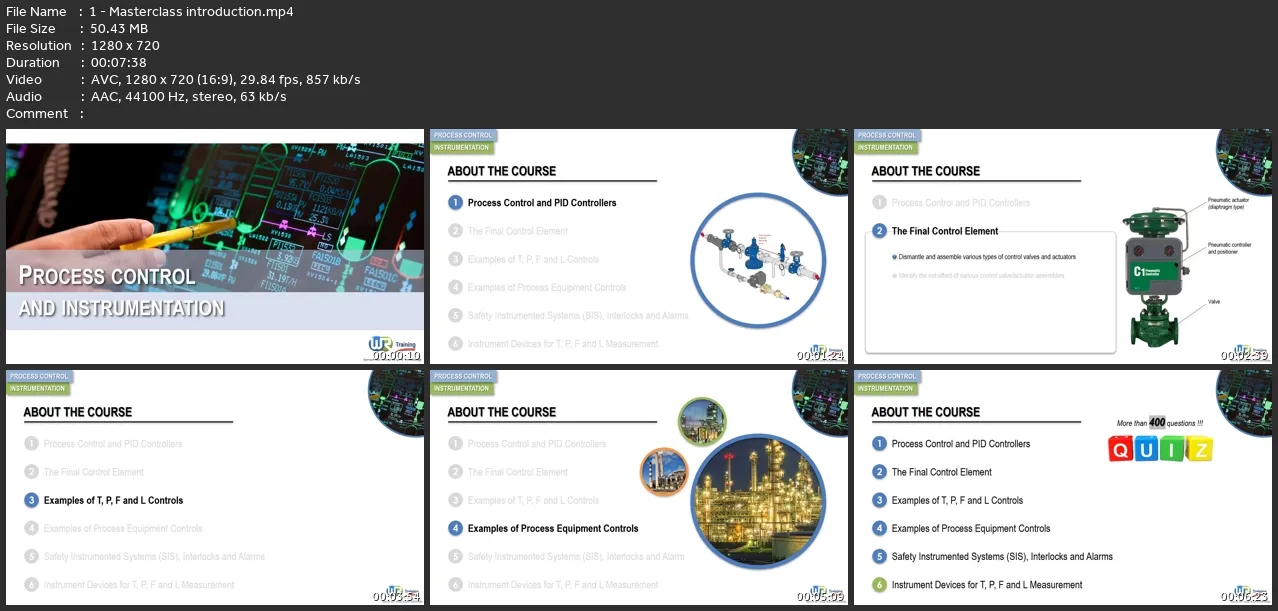Process Control & Instrumentation 16 Hour Masterclass
MP4 | Video: h264, 1280x720 | Audio: AAC, 44.1 KHz
Language: English (US) | Size: 3.02 GB | Duration: 16h 33m
MP4 | Video: h264, 1280x720 | Audio: AAC, 44.1 KHz
Language: English (US) | Size: 3.02 GB | Duration: 16h 33m
Know & understand process control PID controllers control valves actuators positioners & instrumentation like a pro
What you'll learn
Learn the essentials of process controls and PID controllers for a successful career in process industries
Successfully draw the correct information from basic to advanced process control loops
Master the intricate terminological details of process control (process variable, set point, error, offset, load disturbance…)
Identify any process control loop and describe its main tasks and functionalities
Describe the basic function and method of operation for the main control loop components (sensor, transmitter, controller, actuator, control valve…)
Differentiate between feedback and feedforward control loops
Explain the basic implementation process for each of the following types of control: Cascade, ratio, split range…
Differentiate between On/Off, discrete, multi-step and continuous controllers
Describe the basic mechanism, pros and cons of the following modes of control action: On/Off, Proportional (P), Integral (I), Derivative (D), PI, PID…
Describe the general goal of PID controller tuning
Apply the Ziegler Nicholls method to tune P, PI and PID controllers for optimum performance
Understand control valves working principles for successful operation of your plant and piping systems
Understand control valve construction details (bonnet, stem, disc, seat, packing, body, actuator, positioner…)
Identify and know the principles of operation of common control valve actuators (diaphragm, piston, rack and pinion, scotch yoke)
Dismantle and assemble various types of control valves and actuators using 3D and 2D models
Understand how single acting and double acting pneumatic actuators work through graphics and 3D animations
Know how to convert a single acting spring return actuator to a double acting actuator and vice versa
Understand the concept of failure mode in control valves : Fail Open "FO", Fail Closed "FC", Fail As Is "FAI"
Understand the concept of "Air-to-push-up" and Air-to-push-down"
Understand the concept of "direct-acting" and "reverse-acting"
Know how to convert a fail close actuator to a fail open actuator and vice versa
Understand the concept of valve flow coefficient "Cv" and familiarize yourself with the various units
Know how to determine flowrate and pressure drop through control valves for different valve lifts
Know how to match the valve characteristics to the process
Know how to construct the installation curve for a given control valve
Understand the effect of selecting a control valve larger than necessary
Understand the effect of differential pressure on the valve lift and actuator operation
Differentiate between fast opening, linear and equal percentage valve characteristics
Understand how valve positioners operate
Know the different types of valve positioners (P/P, I/P, force balance, motion balance, digital…)
Understand when a positioner should be fitted
Understand the working principles of I/P converters and how they are used in control valves
Understand the control of pressure in a pipe
Understand the control of flow in a pipe
Understand how self-acting pressure controls work and their applications
Understand how self-acting temperature controls work and their applications
Understand flow merging control
Understand flow splitting control
Understand centrifugal pump control systems (discharge throttling, variable speed drive, minimum flow…)
Understand positive displacement pump control systems (recirculation pipe, variable speed drive, stroke adjustment…)
Understand compressor control systems (capacity control, variable speed drive, anti-surge…)
Understand heat exchanger control systems (direct control, bypass control, back pressure control…)
Understand reactor temperature control systems
Understand fired heater control systems
Understand container and vessel control systems
Understand electric motor control systems (ON / OFF actions)
Know and understand the concept of Safety Instrumented Systems (SIS)
Know and understand the concept of Alarm Systems and Interlocks
Understand through extensive 3D animation the techniques and methods used in process industries to measure temperature, pressure, flow and level
Put your knowledge to the test at the end of each section with a valuable technical quiz (420+ questions and solved problems)
Get access to a set of valuable downloadable resources
Requirements
Some engineering or field knowledge is preferable but not mandatory. All the concepts are explained in depth using an-easy-to-understand language to allow students to build their knowledge from the ground up
Please note that the mathematics in the PID tuning and control valve sizing sections are undemanding. All the work can be done with a hand-held calculator
Description
Welcome to this 16 hour masterclass on process control and instrumentation.This valuable masterclass is organized into 6 parts :Part 1: Process Control and PID* ControllersPart 2: The Final Control Element - Control Valves, Actuators and PositionersPart 3: Practical Examples of Temperature, Pressure, Flow and Level ControlsPart 4: Practical Examples of Process Equipment Controls (Heat Exchangers, Pumps, Compressors, Reactors, Piping Systems…)Part 5: Safety Instrumented Systems (SIS), Interlocks and AlarmsPart 6: Instrument Devices For Temperature, Pressure, Flow and Level MeasurementPart 1 is an essential guide to a complete understanding of process control principles and PID* controllers design and tuning. In this first module, we will break down for you all the process control principles into easily digestible concepts, like feedback controls, open loops, split range controls, self-acting controls… Useful reference data, technical recommendations, field observations and numerous process control schemes are presented in an-easy-to-understand format. This module also cautions the process control engineer that the performance of a properly designed process control system can be severely compromised when used in conjunction with incorrect PID* controller settings. In this regard, PID* controller tuning guidelines and their rationale according to the Ziegler Nicholls method are offered to ensure optimum performance. Typical tuning examples have been included to assist you in understanding how specific formulae are applied.Part 2 focuses on the final control element of any process control system, that is the valve-actuator-positioner assembly. In this second module, you will find valuable insights into the working principles and construction details of the following control elements:Control valves (sliding stem and rotary / fast opening, linear and equal percentage)Mixing and diverting 3-port control valvesDiaphragm actuators ("air-to-push-up" and "air-to-push-down")Piston actuators (Single Acting and Double Acting / Fail Open (FO) and Fail Closed (FC))Rack-and-pinion actuators (Single Acting and Double Acting / Fail Open (FO) and Fail Closed (FC))Scotch Yoke actuators (Single Acting and Double Acting / Fail Open (FO) and Fail Closed (FC))Pneumatic positioners (force balance, motion balance)Digital positionersI/P converters…The module then proceeds through a series of process examples and solved problems that require you to:Dismantle and assemble various types of control valves and actuators using 3D and 2D modelsIdentify the net effect of various control valve/actuator assemblies (direct acting, reverse acting, fail open, fail close…)Convert an actuator from Single Acting to Double Acting configuration and vice versaConvert a control valve/actuator assembly from a Fail Closed (FC) to a Fail Open (FA) configuration and vice versaConstruct the installation curve for a control valveDetermine flowrate and pressure drop through control valves for different valve liftsMatch the valve characteristics to the given applicationExamine the effect of selecting a control valve larger than necessaryExamine the effect of differential pressure on the valve lift and actuator operationDetermine when a positioner should be fitted…This will help you develop the necessary skills to ensure your process control systems run smoothly.Part 3 focuses on fluid properties control. This module identifies different ways in which precise control of temperature, pressure, flow and level is ensured. It provides real industrial examples of process control loops and the keys to interpret them in high quality video lectures. Both self-acting and modulating types of control are discussed in exquisite details.Part 4 introduces you to advanced process control in process industries. It identifies different ways in which precise control is ensured for the main process equipment such as chemical reactors, pumps, compressors, fired heaters and heat exchangers just to name a few. The numerous examples outlined in this module are taken from petroleum refineries, chemical and steam boiler plants, making the knowledge gained in this section extremely valuable to practicing engineers and technicians.Part 5 discusses the important concepts of Safety Instrumented Systems (SIS), Alarm Systems and Interlocks. It presents their anatomy, their requirement, their functions and how they are represented in engineering drawings such as Piping & Instrumentation Diagrams.Part 6 illustrates through 3D animations and cross-sectional views the main control instrument devices to measure temperature, pressure, flow and level. These instruments include thermocouples, RTDs’, Bourdon tube pressure gauges, Coriolis flowmeters, level radars and capillary systems just to name a few…As you proceed through the masterclass, answer the 400+ question quiz to test your knowledge and emphasize the key learning points.The quiz includes:True/False questionsMulti-choice questionsImages, cross-sectional viewsSolved problemsAnd much more…You have our promise that at after completing this masterclass, you will be an advanced process control professional, you won’t be a process control expert but you will be prepared to become one if that is what you want and persist to be. In fact, the knowledge that you will gain will help you understand all process control loops, instrumentations and safety systems so that you can draw the correct information from them. This will set you apart from your peers, whether you are a graduate student, a practicing engineer or a manager, and will give you an edge over your competitors when seeking employment at industrial facilities.So with no further ado, check out the free preview videos and the curriculum of the course and we look forward to seeing you in the first section.Hope to see you thereWR TrainingSpread the wings of your knowledge–––––––––––-* When PID is mentioned, it is with reference to Proportional (P), Integral (I) and Derivative (D) control actionsSafety noteSizing, selection, installation and tuning of process control systems (control valves, actuators, controllers, sensors, wiring…) should not be based on arbitrarily assumed conditions or incomplete information. Merely having a control system does not make a process safe or reliable. Now, while it is obviously impossible to address every installation mistake ever made, we have included a valuable summary of the most frequent installation mistakes encountered in the field. We are confident that this valuable masterclass will help you contribute to the safety of your facility, your fellow workers and yourself.
Who this course is for:
Personnel needing to learn the essentials of process control, PID controllers and instrumentation,Control, Process, Chemical and Design engineers & technicians,Instrumentation engineers & technicians,Maintenance engineers & technicians,Experienced personnel as a refresher course and to broaden their knowledge,Instructional designers and those involved in writing manuals and operational procedures,Anyone else with an interest in how process control and PID controllers should be designed, tuned and used in process industries





